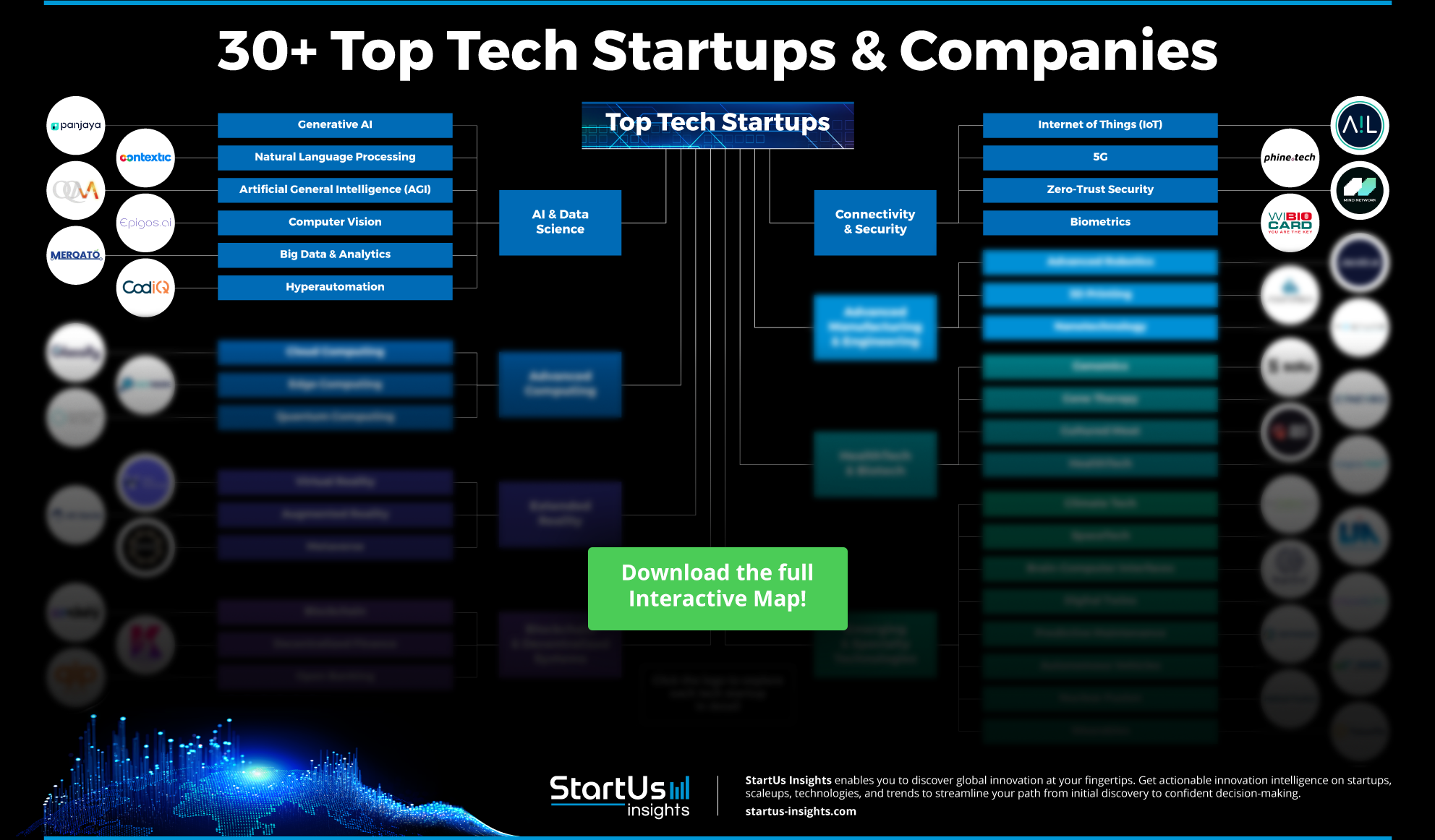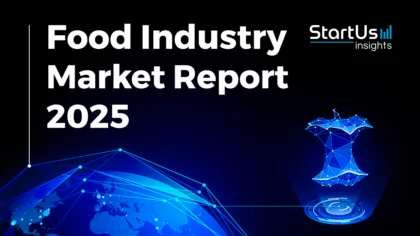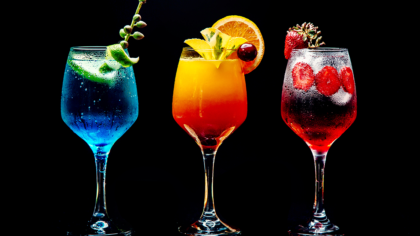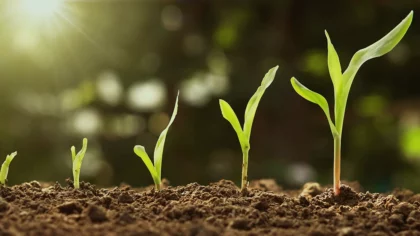The food and beverage industry is undergoing a significant transformation due to the integration of emerging technologies like artificial intelligence (AI), internet of things (IoT), robotics, nanotechnology, 3D printing, and more. These technologies solve various challenges that the industry currently faces — labor shortages, food safety issues, and changing consumer demands, among others. For example, AI and IoT enable automated temperature monitoring to ensure precise control over food safety and quality standards. Restaurants also automate food preparation and delivery using robots. Thus, it is essential for industry stakeholders to keep up with these food and beverage technology advancements to remain competitive.
Why should you read this report?
- Gain insights into the top 10 tech impacting food & beverage.
- Learn about three practical use cases for each technology.
- Meet 10 innovative startups advancing these technologies.

Key Takeaways
- CleanTech
- Use Cases:
- Carbon Capture
- Waste Management
- Sustainable Packaging
- Startup to Watch: FlavaPulse
- Use Cases:
- Additive Manufacturing
- Use Cases:
- On-demand Food Production
- Food Waste Reduction
- Nutritional Customization
- Startup to Watch: Get Nourish3d
- Use Cases:
- Internet of Things (IoT)
- Use Cases:
- Inventory Management
- Equipment Maintenance
- Smart Refrigeration
- Startup to Watch: Thermalog
- Use Cases:
- Nanotechnology
- Use Cases:
- Food Preservation
- Food Safety Detection
- Nano-Encapsulation
- Startup to Watch: Nano9
- Use Cases:
- Artificial Intelligence (AI)
- Use Cases:
- Food Quality Control
- Demand Forecasting
- Predictive Maintenance
- Startup to Watch: Optiwiser A.I. Solutions
- Use Cases:
- Connectivity Technologies
- Use Cases:
- Real-Time Order Tracking
- Digital Signage & Menus
- Smart Shelving
- Startup to Watch: Qromo
- Use Cases:
- Advanced Robotics
- Use Cases:
- Cleaning & Sanitization Robots
- Automated Cooking
- Delivery Robots
- Startup to Watch: Hyper
- Use Cases:
- Augmented Reality (AR) & Virtual Reality (VR)
- Use Cases:
- VR Cooking Experiences
- Training Programs
- Design & Layout Planning
- Startup to Watch: Digital Bites
- Use Cases:
- Blockchain
- Use Cases:
- Supply Chain Transparency
- Regulatory Compliance
- Counterfeit Prevention
- Startup to Watch: Gobbl
- Use Cases:
- Big Data & Analytics
- Use Cases:
- Market Trend Prediction
- Consumer Behavior Analysis
- Competitive Analysis
- Startup to Watch: Winesfere
- Use Cases:
Food and Beverage Industry FAQs
What are the challenges of the food and beverage industry?
- Supply Chain Disruptions: Vulnerabilities in global supply chains lead to delays and increased costs.
- Evolving Consumer Preferences: A shift towards healthier, organic, and sustainable products requires continuous adaptation.
- Regulatory Compliance: Navigating complex and varying regulations across different regions increases operational burdens.
- Food Safety and Quality Control: Ensuring consistent quality and safety standards amidst diverse sourcing practices.
- Consumer Transparency Demands: Increased demand for transparency in sourcing, labeling, and production processes.
Is the food and beverage industry growing?
The food and beverages market has experienced significant growth in recent years, with its size projected to increase from USD 6,576.96 billion in 2023 to USD 8,817.63 billion by 2028 — reflecting a compound annual growth rate (CAGR) of 5.9%. This growth is fueled by increasing urbanization, rising disposable incomes, and a shift towards convenience foods.
Where Did We Get the Food and Beverage Industry Insights from?
StartUs Insights gathers data through its exhaustive Discovery Platform, covering information on 4.7 million startups, scaleups, and tech companies globally, alongside 20,000 emerging technologies and trends. The Discovery Platform accelerates startup and technology scouting, trend intelligence, and patent searches, offering thorough insights into technological advancements.
By leveraging the trend intelligence feature for this report, we identified emerging technologies within specific industries. This process allows us to uncover patterns and trends, and pinpoint relevant use cases and the startups creating solutions for each scenario. Additional capabilities and information can be found at StartUs Insights Discovery Platform.
10 Emerging Technologies Impacting the Future of Food & Beverage Industry
1. CleanTech

As consumer demand for eco-friendly products intensifies, food and beverage companies are adopting cleantech solutions to reduce their environmental footprint, enhance resource efficiency, and comply with sustainability regulations. From utilizing renewable energy sources and implementing waste-to-energy technologies to adopting sustainable packaging and water management systems, cleantech enables the industry to address challenges such as energy consumption, waste generation, and carbon emissions.
3 Practical Use Cases of CleanTech in the Food & Beverage Industry
- Carbon Capture: Carbon capture technologies capture and store CO2 released during food processing. This CO2 is then purified and reused in carbonation or sold, reducing emissions and promoting circular resource use.
- Waste Management: Waste-to-energy technologies convert food waste into energy and compost. This reduces landfill use, lowers emissions, and promotes a circular economy, making waste management more efficient in the food sector.
- Sustainable Packaging: Biodegradable and recyclable packaging materials, reduces reliance on traditional plastics. These innovations decrease packaging waste and environmental harm, aligning the food and beverage industry with sustainability goals.
Startup to Watch: FlavaPulse
Based out of Bulgaria, FlavaPulse is a startup that formulates a clean pea protein concentrate for food and beverage brands seeking sustainable ingredients. The company’s production process involves mechanical screening, which eliminates the need for water and chemicals, ensuring the protein remains clean-label, gluten-free, GMO-free, and allergen-free. This preserves the pea protein’s native functionalities, offering formulators a versatile and reliable ingredient. FlavaPulse thus provides a protein concentrate that enables the creation of healthier, more transparent products, aligning with the growing consumer demand for sustainable and clean-label foods.
2. Additive Manufacturing

Additive manufacturing, commonly known as 3D printing enables the precise and efficient production of customized food products, allowing for innovative designs and the potential for mass personalization. The ability to produce complex structures with minimal material usage aligns with the industry’s growing focus on sustainability and resource efficiency. Additionally, this technology opens new avenues for creating functional foods with tailored nutritional profiles, which is becoming increasingly important as consumer demand for personalized and health-conscious products rises.
3 Practical Use Cases of Additive Manufacturing in the Food & Beverage Industry
- On-demand Food Production: 3D printing allows food manufacturers to produce fresh, customized food items on demand, reducing the need for large inventories and minimizing waste.
- Food Waste Reduction: 3D printing repurposes food by-products and alternative ingredients, converting them into edible products. Thus, turning potential waste into valuable resources for creating new, innovative food items.
- Nutritional Customization: The precise layering of ingredients incorporates exact amounts of vitamins, minerals, and other nutrients, creating personalized meals that address individual health goals, dietary restrictions, or medical conditions.
Startup to Watch: Get Nourish3d
UK-based startup Get Nourish3d utilizes 3D-printing technology to manufacture personalized vitamin gummies, which meet the specific nutritional requirements of each user. The company layers high-impact, bioavailable ingredients into customized gummy stacks, formulating them based on individual health data and preferences. These gummies, which are vegan and sugar-free, enhance nutrient absorption through precise dosage and targeted delivery mechanisms. The startup applies computational algorithms and its 3D-printing platform to produce nutrient stacks that address health concerns like energy levels, immunity, or cognitive function. This process optimizes the bioavailability of essential vitamins and minerals and delivers a solution that supports personalized wellness.
3. Internet of Things (IoT)

By connecting physical devices, IoT enables real-time data collection and analysis across the food supply chain. This improves efficiency, transparency, and sustainability. Within food processing and distribution sectors, IoT-driven systems provide end-to-end visibility to reduce waste and ensure food safety. As the industry continues to face challenges related to resource management and sustainability, IoT streamlines operations and responds to evolving consumer expectations.
3 Practical Use Cases of IoT in the Food & Beverage Industry
- Inventory Management: IoT sensors enable real-time tracking of stock levels, expiration dates, and storage conditions, allowing precise inventory control. This minimizes waste, prevents stockouts, and ensures optimal freshness.
- Equipment Maintenance: Monitoring equipment performance and leveraging predictive maintenance reduces downtime and extends equipment lifespan.
- Smart Refrigeration: IoT-enabled refrigeration systems monitor temperature, humidity, and energy usage in real time to optimize cooling efficiency and reduce energy consumption while ensuring food safety.
Startup to Watch: Thermalog
Thermalog is a startup from Australia that develops self-installable wireless sensors to monitor and protect food storage environments. These sensors continuously track temperature and humidity levels within refrigeration and freezer units, sending immediate notifications via text, email, or audio/visual alarms when conditions deviate from safe ranges. The technology integrates with existing food storage systems. Features include customizable alert thresholds, long battery life, and wireless connectivity, which are essential for maintaining food safety and compliance in restaurants, cafes, and other food service establishments. Thermalog’s sensors thus prevent spoilage, reduce waste, and ensure the quality and safety of stored food products.
4. Nanotechnology

Nanotechnology solves longstanding challenges in food safety, quality, and sustainability. By engineering materials at the nanoscale, it enables the creation of novel solutions that enhance food preservation, nutrient delivery, and contamination detection. This technology leads to innovations such as nano-sensors for real-time monitoring of food safety, nano-packaging that prolongs shelf life, and nano-carriers that improve the efficiency of agrochemicals, thereby reducing environmental impact.
3 Practical Use Cases of Nanotechnology in the Food & Beverage Industry
- Food Preservation: Nano-coatings and additives prevent oxidation and microbial growth. This extends shelf life and maintains product freshness without altering sensory qualities.
- Food Safety Detection: Nanosensors detect pathogens, toxins, and contaminants at the molecular level to increase food safety throughout the supply chain.
- Nano-Encapsulation: Nano-encapsulation protects and delivers bioactive compounds, flavors, and nutrients for targeted release and enhanced stability. This improves the nutritional and functional properties of foods.
Startup to Watch: Nano9
US-based startup Nano9 uses advanced nanotechnology to enhance the bioavailability of nutraceuticals by reducing active ingredients to nanometer-sized particles and suspending them in a nanosuspension. This significantly improves solubility and absorption by increasing surface area, enabling efficient cellular uptake and rapid systemic distribution. The nanosuspension stabilizes these particles, ensuring even dispersion in dietary supplements and beverage products. This enables precise control of particle size and distribution, leading to consistent dosing and improved efficacy. Nano9’s technology thus maximizes the therapeutic potential of nutrients.
5. Artificial Intelligence

Machine learning algorithms analyze vast datasets to optimize supply chains, enhancing operational efficiency, and ensuring quality control. AI models predict market trends, automate complex processes, and enable real-time decision-making, addressing challenges such as food safety, waste management, and predictive maintenance. By integrating AI, companies achieve enhanced demand forecasting, streamlined production, and minimized operational costs, while maintaining product quality and safety.
3 Practical Use Cases of AI in the Food & Beverage Industry
- Food Quality Control: Using computer vision and machine learning algorithms, AI systems analyze standard operating procedures (SOPs) to detect inconsistencies and contaminations. These automated inspections enable consistent quality and safety standards while reducing human error.
- Demand Forecasting: AI-powered analytics predict consumer demand by analyzing historical sales data, market trends, and external factors for accurate production planning and inventory management.
- Predictive Maintenance: AI algorithms monitor food production or storage equipment performance in real time to identify potential failures. This allows timely repairs, reduces downtime, and extends equipment life, enhancing operational efficiency and lowering maintenance costs.
Startup to Watch: Optiwiser A.I. Solutions
German startup Optiwiser A.I. Solutions develops AI-driven supply chain planning software for food and beverage manufacturers, optimizing inventory management and reducing waste. The software leverages AI and advanced algorithms to predict demand, determine optimal inventory levels, and calculate cost-efficient production lot sizes. It automates the planning process, integrating real-time data to adapt to fluctuating market conditions and seasonal variations. Key benefits include minimizing stock-outs, reducing overproduction, and enhancing overall supply chain efficiency. By streamlining operations and maximizing resource utilization, Optiwiser A.I. Solutions enables manufacturers to reduce food waste, improve profitability, and ensure consistent product availability.

6. Connectivity Technologies

Connectivity technologies like Wi-Fi, 5G, Bluetooth, and GPS are advancing the food and beverage industry by enabling real-time data exchange. This enables food companies to enhance operational transparency and automate processes. For instance, contactless payment systems, real-time order tracking, and adaptive digital signage improve customer experience.
3 Practical Use Cases of Connectivity Technologies in Food & Beverage Industry
- Real-Time Order Tracking: GPS connectivity enables continuous tracking of orders, providing food outlets and consumers with live updates on location, status, and estimated delivery times.
- Digital Signage & Menus: Wi-Fi ensures seamless, high-bandwidth updates to digital displays, allowing restaurants to instantly change menus, prices, and promotions across locations. Bluetooth facilitates personalized customer interactions, such as proximity-based menu adjustments and targeted offers.
- Smart Shelving: Wi-Fi supports real-time inventory tracking and dynamic pricing updates across large retail areas, while Bluetooth enables close-range interactions, such as automated product scanning and shelf-level data collection.
Startup to Watch: Qromo
Italian startup Qromo develops a system for managing direct sales in the food and beverage industry, both in physical locations and online. The company’s technology streamlines operations by offering configurable management software, digital menus, and payment solutions, including POS readers, tap-to-pay options, and mobile integrations. Businesses can independently set up the system in minutes, enabling efficient management of in-house dining, delivery, and takeaway services. Key features include quick setup, real-time order tracking, and secure payment processing, which enhance operational efficiency and improve customer experience. This way, Qromo enables food and beverage businesses to optimize their sales processes and deliver better service.
7. Advanced Robotics

Advanced robotic systems are integrated into various stages of food manufacturing, from processing and packaging to quality control and logistics. These systems enhance productivity by automating repetitive tasks such as sorting, cutting, and palletizing.. Robotics also addresses labor shortages by performing tasks that are difficult or undesirable for human workers. Moreover, the integration of robotics with digital technologies, such as IoT and AI, enables real-time monitoring and optimization of production lines, further improving operational efficiency and safety.
3 Practical Use Cases of Advanced Robotics in Food & Beverage Industry
- Cleaning & Sanitization: These robots utilize AI and sensors to autonomously navigate and disinfect facilities, ensuring compliance with food safety regulations and minimizing contamination risks.
- Automated Cooking: Such systems leverage robotics to precisely control cooking parameters and ensure consistent product quality. They also reduce waste while optimizing energy use.
- Delivery Robots: Equipped with advanced navigation systems and temperature control, delivery robots autonomously transport food within facilities or to consumers. This reduces labor costs and maintains food quality during transit.
Startup to Watch: Hyper
Hyper is a startup from Israel that advances the fast food industry with its fully autonomous, self-contained robotic restaurant system. The company integrates robotics, advanced AI, and automated kitchen operations to prepare and serve fast food without human intervention. The system operates in a compact, mobile unit, capable of functioning in various locations to meet on-demand consumer needs. Key features include precise cooking techniques, real-time monitoring, and customizable meal options. By merging automation with culinary expertise, Hyper streamlines fast food delivery, offering a scalable solution that addresses industry demands for efficiency, hygiene, and consumer satisfaction.
8. Augmented Reality (AR) & Virtual Reality (VR)

The integration of AR and VR in the food and beverage industry improves customer engagement and workforce training. These technologies enable immersive simulations, real-time data visualization, and interactive food design processes, enhancing decision-making, reducing operational costs, and accelerating innovation in product development and facility management.
3 Practical Use Cases of AR & VR in the Food & Beverage Industry
- VR Cooking Experiences: VR cooking experiences simulate complex culinary environments, allowing chefs and food technologists to experiment with recipes, optimize techniques, and streamline kitchen workflows without physical ingredients or setups.
- Training Programs: AR and VR enhance training programs by providing immersive, hands-on simulations of food preparation, safety protocols, and equipment handling, leading to improved skill acquisition and retention.
- Design & Layout Planning: AR and VR enable precise design and layout planning by allowing food manufacturers to visualize and interact with 3D models of production lines, kitchens, and retail spaces.
Startup to Watch: Digital Bites
Greek startup Digital Bites simplifies the product development process in the food industry with its VR-based consumer insights testing platform. The company’s technology enables food businesses to import new product designs and competitor data into a virtual environment, where they are able to conduct immersive experiments with target audience samples. By selecting from existing VR experiments or creating custom ones, businesses simulate real-world scenarios to test consumer reactions. The platform’s AI algorithm then analyzes the collected data, generating detailed reports and actionable insights. Key benefits include faster validation of food concepts, the ability to test marketing strategies, and the support of R&D teams in making data-driven decisions.
9. Blockchain

Blockchain enables a decentralized, immutable ledger for food and beverage companies to improve traceability and transparency across the supply chain. It allows for real-time verification of the origin, quality, and safety of food products. By securing data on sourcing, processing, and distribution, blockchain reduces the risks of contamination, fraud, and counterfeiting.
3 Practical Use Cases of Blockchain in the Food & Beverage Industry
- Supply Chain Transparency: Blockchain enables end-to-end visibility in supply chains by securely recording each transaction, from farm to table, ensuring traceability, reducing fraud, and enhancing consumer trust in product authenticity.
- Regulatory Compliance: Blockchain streamlines regulatory compliance by automating documentation and providing auditable records that are immutable and transparent, simplifying adherence to food safety standards and reducing the risk of non-compliance.
- Counterfeit Prevention: Blockchain combats counterfeit products by assigning unique, tamper-proof digital identities to food items, allowing stakeholders to verify authenticity and origin, thereby protecting brands and consumers from fraudulent goods.
Startup to Watch: Gobbl
Gobbl is a startup from UAE that develops a decentralized ecosystem of food-focused dApps. The company’s platform connects decentralized applications across delivery, social engagement, gaming, and loyalty programs. It provides a modular framework that allows developers to rapidly build and deploy customized applications, addressing industry-specific challenges like optimizing delivery logistics, enhancing loyalty programs through tokenization, and enabling secure, transparent transactions. The platform utilizes Ethereum Layer-2 to ensure high scalability, low latency, and minimal transaction costs while maintaining security and data integrity. By leveraging smart contracts and decentralized ledgers, Gobbl ensures that food businesses are able to automate processes, reduce intermediaries, and maintain control over data.
10. Big Data & Analytics

Big data and analytics allows the food and beverage sector to analyze vast amounts of data from production, supply chain, and consumer behavior. Predictive analytics forecast demand trends while big data solutions enhance product quality control by identifying patterns and anomalies. This informs product development by uncovering consumer preferences and emerging market trends.
3 Practical Use Cases of Big Data & Analytics in the Food & Beverage Industry
- Market Trend Prediction: Big data and analytics predict market trends by analyzing consumer purchasing patterns, seasonal demand, and emerging dietary preferences. This allows companies to proactively adjust product lines and marketing strategies.
- Consumer Behavior Analysis: Detailed insights into consumer behavior, including purchasing frequency, brand loyalty, and dietary habits, enable businesses to create targeted marketing campaigns and tailor food products.
- Competitive Analysis: Companies are able to leverage multi-source datasets to gain granular insights into market dynamics, consumer segmentation, and algorithmic competitor benchmarking, enabling data-driven product offering decisions.
Startup to Watch: Winesfere
New Zealand-based startup Winesfere develops a global wine trading platform that utilizes business intelligence (BI) technology to deliver data-driven insights for optimizing wine trade operations. The platform aggregates and processes large datasets from various sources, enabling users to analyze market trends, predict price movements, and identify high-potential trade opportunities. Winesfere’s BI engine employs advanced algorithms and predictive models to transform complex data into actionable insights, allowing traders to make informed decisions with greater precision. The platform features real-time analytics, trend forecasting, and detailed market segmentation — which provide a data-driven view of global wine markets. Winesfere thus enables strategic decision-making and enhanced efficiency of wine trading activities.
Outlook for the Food and Beverage Industry
Patents & Grants
The industry’s commitment to innovation is evident with startups driving the development of over 92,100 patents and securing more than 6,240 grants, reflecting robust research and development efforts and strong investor confidence.
For more actionable insights, download our free Food & Beverage Innovation Report.
Investment Landscape
With an average investment value of USD 10 million per round, the F&B industry is supported by the participation of thousands of investors. The top investment rounds being seed, early stage VC/series A, accelerator/incubator, pre-seed, and non-equity assistance. Leading investors include Techstars, Y Combinator, Gbeta, Google for Startups, and Sosv.
Global Footprint
Geographically, the industry maintains a global footprint, with the USA, UK, India, Germany, and Canada emerging as key innovation hubs. Notably, city hubs like New York City, London, Singapore, Melbourne, and Sydney serve as central nodes for technological breakthroughs, fostering vibrant ecosystems of innovation.
Don’t Miss Out on the Latest Food and Beverage Innovations
Ready to leverage the latest food and beverage technologies shaping the future? With StartUs Insights, you gain quick and easy access to over 4.7 million startups, scaleups, and tech companies, along with 20,000 emerging technologies and trends. Our AI-powered search and real-time database provide exclusive solutions that set you apart from the competition.
Industry giants like Samsung, Nestlé, and Magna trust our innovation intelligence tools to lead trends, optimize operations, and uncover new market opportunities. For example, here’s what Jürgen Ellmeier, Business Development & eCommerce Manager of Nestlé says about our platform & service, “StartUs Insights’ exhaustive insights give us a comprehensive understanding of FMCG Innovation Trends and helps us discover top startups.”
Like them, you can also benefit from our unmatched data, comprehensive industry views, and reliable insights to drive strategic decision-making. Get in touch to learn how our tailored discovery options can accelerate your innovation journey.
Explore All Food & Beverage Tech & Startups!

![Food and Beverage Industry: Top 10 Technology Trends [2025 & Beyond]](https://www.startus-insights.com/wp-content/uploads/2024/11/Food-and-Beverage-Industry-Trends-SharedImg-StartUs-Insights-noresize-420x236.webp)






